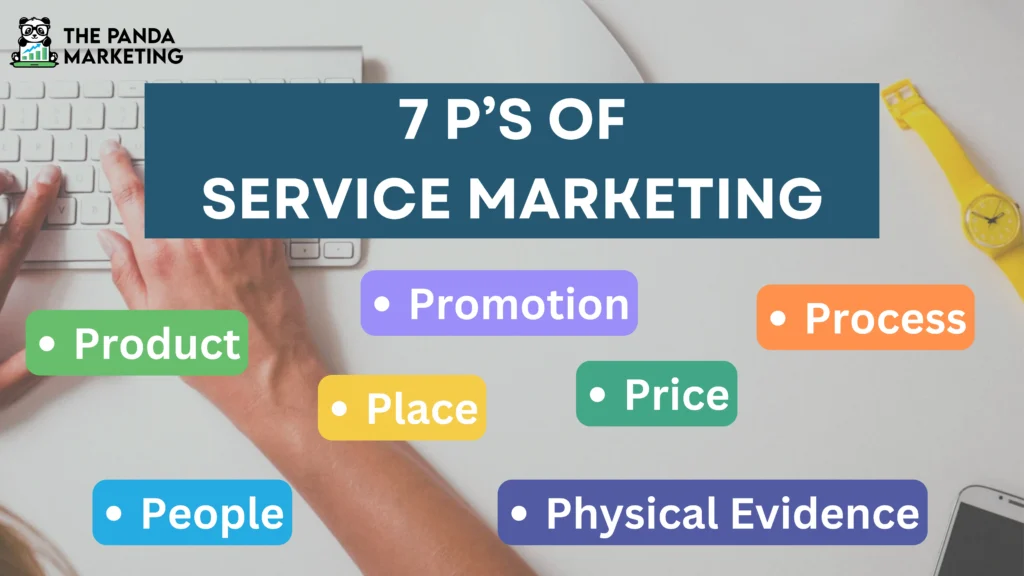
Table of Contents
Introducing the 7 P’s of Service Marketing: A Blueprint for Success
In today’s fast-paced business environment, understanding and implementing effective marketing strategies is essential, especially for service-based businesses. The concept of the 7 P’s of service marketing serves as a vital framework for companies aiming to enhance their marketing efforts. Unlike traditional product marketing, service marketing requires a unique approach due to the intangible nature of services. Let’s dive deep into the 7 P’s of service marketing and explore how they can transform your business.
What Are the 7 P’s of Service Marketing?
The 7 P’s of service marketing are a set of key elements that help businesses market their services effectively. Each P plays a critical role in crafting a comprehensive marketing strategy that can attract and retain customers, improve service delivery, and boost overall business performance.

The Importance of the 7 P’s in Service Marketing
Why are the 7 P’s of service marketing so important? Services are intangible, heterogeneous, and perishable, making their marketing more complex than that of physical products. The 7 P’s framework helps businesses address these challenges by providing a structured approach to planning, executing, and evaluating their marketing efforts. By focusing on each element, businesses can ensure a consistent and high-quality customer experience, which is crucial for success in the service industry.
Product
Definition
The service itself is the “product” in service marketing. Unlike tangible goods, services cannot be seen, touched, or owned. They are experiences or performances provided to customers, such as a haircut, legal advice, or a hotel stay. Understanding the nature of your service is the first step in effectively marketing it.
Customization and innovation
Customization and innovation are key aspects of the product element in service marketing. To stand out in a competitive market, businesses must tailor their services to meet the specific needs and preferences of their target audience. This could involve personalizing the service experience, offering unique features, or continuously innovating to add value. For example, a spa might offer customized treatment plans based on individual customer needs, enhancing the overall experience and satisfaction.
Price
Pricing Strategies
Pricing is a crucial component of the 7 P’s of service marketing. It not only affects a company’s profitability but also influences customers’ perceptions of the service. Different pricing strategies can be employed, such as cost-based pricing, value-based pricing, or competition-based pricing, depending on the service and market conditions.
Factors Influencing Pricing
Several factors influence pricing decisions in service marketing, including the cost of delivering the service, customer demand, competition, and perceived value. For instance, a premium pricing strategy might be suitable for a luxury hotel that offers exclusive services, while a competitive pricing strategy could attract price-sensitive customers to a budget-friendly travel agency.
Place
Distribution Channels in Service Marketing
“Place” in service marketing refers to the distribution channels used to deliver the service to customers. Unlike physical products, services are often produced and consumed simultaneously, making the place of delivery crucial. This could involve physical locations, online platforms, or mobile services.
Role of Location
The location of the service is vital in service marketing. It needs to be accessible and convenient for the target audience. For example, a fitness center located in a residential area can attract more customers due to its proximity, while an online tutoring service can reach a global audience through a well-designed website and robust digital infrastructure.
Promotion
Promotional Strategies
Promotion involves the various tactics used to communicate with and persuade potential customers to use the service. Effective promotional strategies may include advertising, sales promotions, public relations, and personal selling.Making use of digital marketing channels is a necessity in today’s digital world if you want to reach a larger audience.
The importance of Digital Marketing
Digital marketing plays a significant role in the promotion of services. Utilizing social media platforms, email marketing, search engine optimization (SEO), and pay-per-click (PPC) advertising can enhance a service’s visibility and attract more customers. For instance, a digital marketing agency might use content marketing and social media campaigns to showcase their expertise and attract new clients.
People
The Role of Employees
People are at the heart of service marketing. Employees play a critical role in delivering the service and shaping the customer experience. Their skills, attitudes, and behaviors can significantly impact service quality and customer satisfaction.
Training and development
Investing in employee training and development is essential for maintaining high service standards. Well-trained and motivated staff can enhance service delivery, handle customer inquiries effectively, and create a positive service experience. For example, a customer service representative who is knowledgeable and empathetic can resolve issues more efficiently, leading to higher customer satisfaction.
Process
Definition of Process in Service Marketing
The process refers to the procedures and mechanisms through which the service is delivered. It encompasses everything from how customers are greeted to the actual service delivery and post-service follow-up.
Streamlining Processes
Streamlining processes is crucial to ensuring efficiency, consistency, and quality in service delivery. This involves optimizing each step of the service delivery process to minimize wait times, reduce errors, and enhance overall customer satisfaction. For instance, a restaurant might implement a streamlined ordering and delivery system to ensure fast and accurate service.
Physical Evidence
Importance of Tangibles in Services
Physical evidence includes the tangible elements that customers associate with the service. This could be the physical environment where the service is delivered, branding materials, or any other tangible cues that reinforce the service quality.
Creating a Positive First Impression
Creating a positive first impression through well-designed physical evidence can enhance customer trust and satisfaction. For example, a clean and welcoming reception area in a dental clinic can reassure patients and set the tone for a positive service experience.
7P’s: A Unified Approach to Service Marketing
The 7 P’s of service marketing do not operate in isolation; they are interconnected and influence each other. For maximum effectiveness, businesses should integrate these elements into a cohesive marketing strategy. This holistic approach ensures that all aspects of the service are aligned and work together to deliver a superior customer experience.
7P’s in Action: Case Studies in Service Marketing
Several companies have successfully implemented the 7 P’s of service marketing. For example, Starbucks integrates the 7 P’s by offering a high-quality product (coffee), strategic pricing, convenient locations, effective promotions, trained staff, efficient processes, and a welcoming physical environment.
These real-world examples provide valuable lessons for other businesses. They highlight the importance of a cohesive marketing strategy that encompasses all elements of the 7 P’s and demonstrates the benefits of continuous evaluation and adaptation.
The 7P’s Puzzle: Solving the Challenges of Service Marketing
Common Obstacles
Implementing the 7 P’s of service marketing can be challenging. Common obstacles include aligning all elements consistently, managing customer expectations, and adapting to market changes. These challenges require careful planning, continuous evaluation, and flexibility to overcome.
Overcoming these challenges
To overcome these challenges, businesses should regularly review and adjust their 7 P’s strategy. This involves gathering customer feedback, monitoring market trends, and being willing to make necessary changes. For example, a hotel might regularly update its amenities and services based on guest reviews and industry trends to stay competitive.
The 7P’s Payoff: How They Can Enhance Your Service Business
Enhancing customer satisfaction
Applying the 7 P’s of service marketing can significantly enhance customer satisfaction. By focusing on each element, businesses can create a seamless and enjoyable service experience that meets and exceeds customer expectations.
Improving brand loyalty
Effective implementation of the 7 P’s can also improve brand loyalty. Satisfied customers are more likely to return and recommend the service to others, leading to increased customer retention and positive word-of-mouth marketing.
Mastering the 7P’s: Tips for Service Marketing Success
To optimize the 7 P’s in your business, consider the following practical tips:
Regularly Review Pricing: Adjust your pricing strategy based on market trends and customer feedback.
- Invest in Training: Ensure your employees are well-trained and motivated to deliver exceptional service.
- Leverage Digital Marketing: Utilize digital channels to enhance your promotional efforts and reach a broader audience.
- Streamline Processes: Continuously optimize your service delivery processes to improve efficiency and customer satisfaction.
- Enhance Physical Evidence: Ensure that all tangible elements associated with your service reinforce its quality and create a positive impression.
Essential Tools and Resources for Optimizing the 7P’s
Utilizing the right tools and resources can help optimize your 7 P’s strategy. Customer relationship management (CRM) software, online training platforms, and digital marketing tools can provide valuable insights and support effective implementation.

Conclusion
In conclusion, the 7 Ps of service marketing offer a solid foundation for crafting and implementing effective service strategies. By focusing on product, price, place, promotion, people, process, and physical evidence, businesses can create exceptional service experiences that attract and retain customers. This comprehensive framework ensures a holistic approach to service marketing, enabling businesses to adapt to changing market conditions and customer expectations. Embracing the 7 Ps as a core element of your service strategy can lead to enhanced customer satisfaction, improved brand loyalty, and long-term business success.
FAQs ( Frequently Asked Questions )
What is the most important P in the 7 P’s of service marketing?
There isn’t a single most important P, as all elements are interconnected and contribute to the overall success of the service marketing strategy. However, many experts consider ‘people’ and ‘process’ to be crucial due to their direct impact on customer experience and service delivery.
How can small businesses implement the 7 P’s effectively?
Small businesses can implement the 7 P’s effectively by starting with a thorough understanding of their target audience and tailoring each P to meet their specific needs. They should regularly gather customer feedback, be adaptable, and focus on continuous improvement. Leveraging digital marketing tools and investing in staff training can also make a significant difference.
Are the 7 P’s applicable to all service industries?
Yes, the 7 P’s framework is versatile and can be applied across various service industries, from hospitality to healthcare. It helps businesses of all types meet customer expectations and stay competitive by addressing the unique challenges of service marketing.
How often should a business review its 7 P’s strategy?
It’s advisable for businesses to review their 7 P’s strategy at least annually or whenever there are significant changes in the market or within the business. Regular reviews ensure the strategy remains relevant and effective in meeting business goals and customer needs.
What are some common mistakes businesses make with the 7 P’s?
Common mistakes include neglecting employee training (people), inconsistent service delivery (process), poor physical environments (physical evidence), and a lack of alignment between the 7 P’s. Ensuring that all elements are well-aligned and continuously improved can help avoid these pitfalls.



